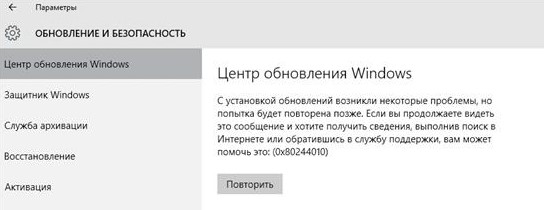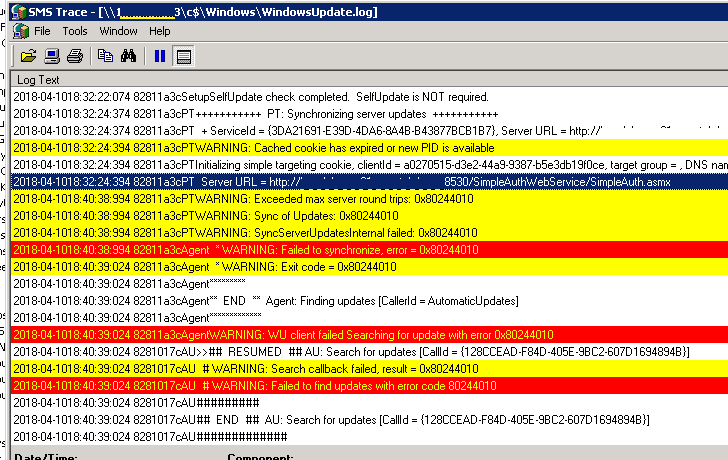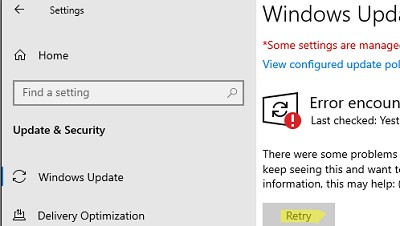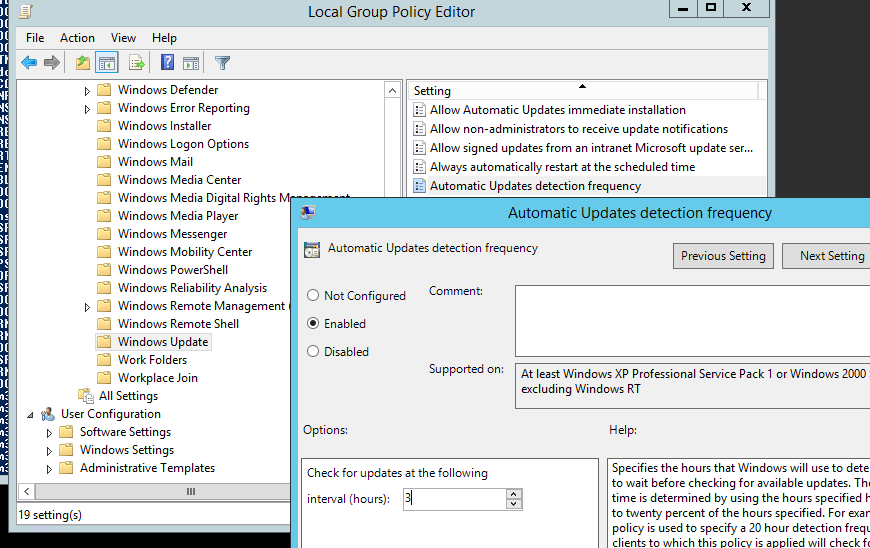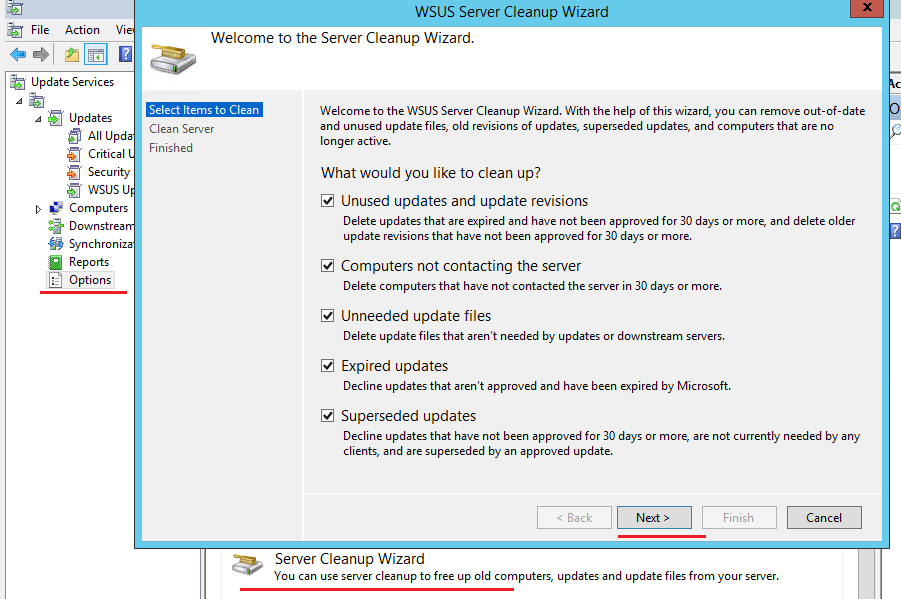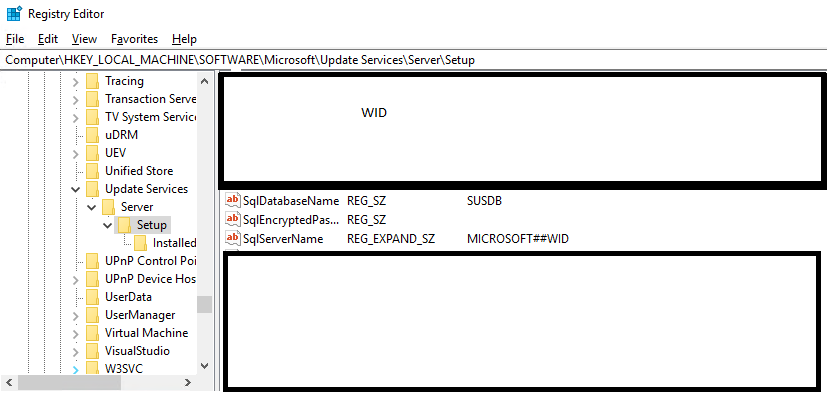После установки нового сервера WSUS в сети нашей компании многие клиенты не смогли получить новые обновления с сервера с ошибкой 0x80244010. Как оказалось, эта ошибка характерна не только для компьютеров, обновляющихся с внутреннего сервера WSUS, но и для устройств, получающих обновления напрямую с Windows Update. Рассмотрим, основные способы исправления ошибки 0x80244010 и восстановления работоспособности системы обновлений.
Если вы увидели ошибку получения или установки обнволения в графической Control Panel или панели Settings, нужно открыть лог агента WindowsUpdate.log. В старых версиях Windows 7 и 8 это файл
%Windir%\WindowsUpdate.log
. В современных Windows 10/11 и Windows Server 2022/2019 вы можете сгенерировать файл WindowsUpdate.log с помощью PowerShell:
Get-WindowsUpdateLog -logpath C:\PS\Logs\WindowsUpdate.log
В моем случае в журнале обновлений обнаружились такие ошибки:
PT WARNING: Exceeded max server round trips: 0x80244010 PT WARNING: Sync of Updates: 0x80244010 PT WARNING: SyncServerUpdatesInternal failed: 0x80244010 Agent * WARNING: Failed to synchronize, error = 0x80244010 Agent * WARNING: Exit code = 0x80244010 Agent ********* Agent ** END ** Agent: Finding updates [CallerId = AutomaticUpdates] Agent ************* Agent WARNING: WU client failed Searching for update with error 0x80244010 AU >>## RESUMED ## AU: Search for updates [CallId = {128CCEAD-F84D-405E-9BC2-607D1694894B}]
AU # WARNING: Search callback failed, result = 0x80244010 AU # WARNING: Failed to find updates with error code 80244010
Обратите внимание на строку Exceeded max server round trips: 0x80244010. Эта ошибка говорит, что при обращении к серверу обновлений (в моем случае это WSUS) было превышено максимальное количество обращений. В результате чего сервер обновлений отключает клиента, который превысил лимит обращений (по умолчанию лимит — 200 обращений).
Также в Windows Update есть ограничение в 200 Кб на максимальный размер XML файла, который клиент получает с сервера в рамках одного обращения. Чем большее количество обновлений на сервере для клиента нужно проверить, тем больший размер XML файла. Если клиент не смог получить необходимые данные с сервера обновлений за 200 сессий, он временно отключается от сервера и возвращает ошибку.
Чаще всего такая ошибка возникает из-за плохого или нестабильного сетевого соединения с сервером обновлений, или когда клиенту нужно получить слишком большое количество обновлений (новый клиент сервера WSUS или компьютер, на котором давно не устанавливались обновлений).
В большинстве случаев пользователю достаточно через несколько минут повторно нажать на кнопку Retry/ Check for Updates в панели управления или выполнить команду:
wuauclt.exe / detectnow
В большинстве случаев это решает проблему, но в том случае если клиентов в сети много, такой способ решения проблемы неприемлем.
По умолчанию клиент проверяет обновления на сервере каждые 22 часа. Вы можете изменить этот интервал с помощью параметров групповых политик компьютера. Откройте редактор локальной GPO (
gpedit.msc
) или отредактируйте доменные политику в консоли Group Policy Management Console (
gpmc.msc
). Перейдите в раздел Computer Configuration -> Administrative Templates -> Windows Components -> Windows Update.
Включите параметр Automatic Update detection frequency и увеличьте частоту синхронизаций клиента с сервером обновлений до 3 часов.
Также можно на стороне сервера WSUS убрать ограничение на максимальный размер XML файла, который может скачать клиент с сервера. Для этого откройте SQL Server Management Studio и подключитесь к базе данных SUSDB. Выполните выполнить следующую команду T-SQL.
USE SUSDB
GO
Проверьте и запомните текущее значение:
select MaxXMLPerRequest from tbConfigurationC
Отключите ограничение:
UPDATE tbConfigurationC SET MaxXMLPerRequest = 0
Чтобы не менять настройки в базе WSUS, можно выполнить очистку WSUS сервера с помощью встроенного мастера очистки (Консоль Update Service -> Options -> Server Cleanup Wizard -> все опции -> Next). Это удалит старые, неиспользуемые, и замененные обновления (особенно много мусора от обновлений MS Office), из-за которых может долго выполняться сканирование.
В результате такой операции, клиент Windows Update будет получать намного меньше мета-информации с WSUS сервера, и его взаимодействие должно уместиться в 200 сессий по 200кб.
Также попробуйте увеличить производительность пула WsusPool в IIS на сервере WSUS по рекомендация из стати Ошибка обновления Windows 80244022
WsusPool (Application Pools -> WsusPool -> Advanced settings):
- Private Memory Limit (KB) – 0 (убрать лимит 1.2 на использование RAM рабочим процессов WSUS)
- Queue Length — 25000 (увеличить длину очереди к пулу приложения с 10000)
- Limit Interval (minutes) — 15 (увеличить минут время для сброса счетчиков и выполнения CPU Throttling с 5 минут до 15)
- Service Unavailable Response — TcpLevel (при старом значение HttpLevel клиенту возвращается ошибка HTTP 503)
Отредактируйте файл config ( C:\Program Files\Update Services\WebServices\ClientWebService\web.config), заменив строку
httpRuntime maxRequestLength="4096"
на
httpRuntime maxRequestLength="204800" executionTimeout="7200"
Если все рассмотренные способы не помогли исправить ошибку обновления на клиенте, попробуйте полностью сбросить на нем настройки Windows Update и восстановить настройки по-умолчанию. После чего выполните несколько циклов поиска обновлений.
- Remove From My Forums
-
Question
-
-
Edited by
Friday, October 11, 2019 7:25 AM
-
Edited by
Answers
-
Hi Birdal,
As the article you provided says:
- We have defined the maximum number of trips as 200 within code and it cannot reconfigured.
So, if you click «Update Now» and the error «0x80244010» appears at the end, then the automatic update is normal, and only the update information is completely obtained by this update. Then continue to click «Update Now». As
for how many times you need to click to update immediately, it depends on how many patches you need to install for the installed operating system.
Regards,
Yic
Please remember to mark as answers if they help.
If you have feedback for TechNet Subscriber Support, contact
tnmff@microsoft.com.-
Marked as answer by
_Birdal
Friday, October 11, 2019 1:10 PM
- We have defined the maximum number of trips as 200 within code and it cannot reconfigured.
Skip to content
This error is mostly raised when a Windows client hasn’t been updated for a long time or when the software distribution store is cleaned and need to build up again. The default round trip value is capped to a maximum of 200KB per client each request, while the metadata XML file can grow to a larger file.
There are 2 possible solutions for this problem.
- The good old reboot. Just reboot, retry a couple of times and everything magically starting to work.
- Remove the maximum XML file size limit. This is one is more difficult, but way more efficient because you don’t have to troubleshoot each failing client. Will discuss this one below.
How to run queries against the WSUS Database?
The first thing, you need to know which database type is running for your WSUS instance. It can be the (default) Windows WID Database or SQL (express). To find out which database, navigate to the following registry key or run this PowerShell script on your WSUS server:
|
(Get-ItemProperty -Path «HKLM:\SOFTWARE\Microsoft\Update Services\Server\Setup» -name «SqlServerName»).sqlservername |
The manual method, navigate to: HKLM:\SOFTWARE\Microsoft\Update Services\Server\Setup
Query the WSUS WID Database
PowerShell Script Example to change the MaxXMLPerRequest value.
|
$ConnectionString = ‘server=\\.\pipe\MICROSOFT##WID\tsql\query;database=SUSDB;trusted_connection=true;’ $SQLConnection= New-Object System.Data.SQLClient.SQLConnection($ConnectionString) $SQLConnection.Open() $SQLCommand = $SQLConnection.CreateCommand() $SQLCommand.CommandText = ‘UPDATE tbConfigurationC SET MaxXMLPerRequest = 0’ $SqlDataReader = $SQLCommand.ExecuteReader() $SQLConnection.Close() |
Query the WSUS SQL Express Database
PowerShell Script Example to change the MaxXMLPerRequest value.
|
$DBType = ‘localhost\sqlexpress’ Invoke-Sqlcmd -Query «UPDATE tbConfigurationC SET MaxXMLPerRequest = 0» -ServerInstance $DBType -Database «SUSDB» $SQLDataResult = Invoke-Sqlcmd -Query «SELECT MaxXMLPerRequest FROM tbConfigurationC» -ServerInstance $DBType -Database «SUSDB» |
The final script
|
1 2 3 4 5 6 7 8 9 10 11 12 13 14 15 16 17 18 19 20 21 22 23 24 25 26 27 28 29 30 31 32 33 34 35 36 37 38 |
$DBType = (Get-ItemProperty -Path «HKLM:\SOFTWARE\Microsoft\Update Services\Server\Setup» -name «SqlServerName»).sqlservername If($DBType -match «WID»){ $ConnectionString = ‘server=\\.\pipe\MICROSOFT##WID\tsql\query;database=SUSDB;trusted_connection=true;’ $SQLConnection= New-Object System.Data.SQLClient.SQLConnection($ConnectionString) $SQLConnection.Open() $SQLCommand = $SQLConnection.CreateCommand() $SQLCommand.CommandText = ‘UPDATE tbConfigurationC SET MaxXMLPerRequest = 0’ $SqlDataReader = $SQLCommand.ExecuteReader() $SQLConnection.Close() $SQLConnection.Open() $SQLCommand = $SQLConnection.CreateCommand() $SQLCommand.CommandText = ‘SELECT MaxXMLPerRequest FROM tbConfigurationC’ $SqlDataReader2 = $SQLCommand.ExecuteReader() $SQLDataResult = New-Object System.Data.DataTable $SQLDataResult.Load($SqlDataReader2) $SQLConnection.Close() IF($SQLDataResult.maxxmlperrequest -eq 0){ Write-host «Succesfully changed the XML Maximum value» } Else { write-host «Something went wrong.. cannot change the DB Value» } } ElseIf($DBType -match «SQL»){ Invoke-Sqlcmd -Query «UPDATE tbConfigurationC SET MaxXMLPerRequest = 0» -ServerInstance $DBType -Database «SUSDB» $SQLDataResult = Invoke-Sqlcmd -Query «SELECT MaxXMLPerRequest FROM tbConfigurationC» -ServerInstance $DBType -Database «SUSDB» IF($SQLDataResult.maxxmlperrequest -eq 0){ Write-host «Succesfully changed the XML Maximum value» } Else { write-host «Something went wrong.. cannot change the DB Value» } } |
Устанавливая обновления ОС при помощи WSUS, порой не избежать появления ошибки 0x80244010. Причина банальна — клиентский компьютер превысил лимит запросов к серверу. WSUS настроен таким образом, что не может «общаться» с другими ПК во время обновления слишком много — изменить или увеличить ограничение на количество обращений (200) невозможно.
Действовать стоит таким образом:
- Используйте wuauclt.exe / detectnow. Для этого на клиентском ПК откройте Командную строку с правами администратора и запускайте через 20-30 минут ранее указанный запрос. Это поможет, хотя для больших сетей такой вариант решения проблемы займет много времени.
- Убедитесь в качественности доступа к сети. Бывает, что обращений клиентов к серверу чересчур много из-за нестабильности соединения.
- Уберите ограничение касательно размера XML-файла. Во время одного запроса клиент и сервер обмениваются таким файлом и по умолчанию он не может быть больше двухсот килобайт, но это можно изменить. Для этого на сервере запустите следующий скрипт в базе данных с обновлениями: USE SUSDB GO UPDATE tbConfigurationC SET MaxXMLPerRequest = 0.
- Почистите базу данных апдейтов. Много чего в ней может дублироваться либо потерять актуальность из-за релиза кумулятивных обновлений. Особо в этом отношении «раздуты» файлы касательно офисных программ.
- Не устанавливайте все обновления сразу. Ошибка 0x80244010 чаще появляется на ПК, которые давно не обновлялись, из-за чего за двести обращений клиент не может получить от сервера все апдейты. Если разделить все обновления на пакеты и устанавливать их постепенно, то неполадки не возникнет.
Windows Error 0x80244010 generally triggers while installing a new WSUS server for many of the Windows clients.
Our Server Administration Techs handles different issues that cause this error on a daily basis.
Today, let us discuss various methods to fix ‘Windows Error 0x80244010’ and restore Windows update subsystem functionality.
Windows Error 0x80244010 – Causes
After installing a new WSUS server, many Windows clients could not receive new updates, resulting in the error 0x80244010. This error is typical also for the devices that receive updates directly from Windows Update servers.
Major causes of Windows Error 0x80244010 includes:
-
Generic glitch
Generic glitch is quite common on Windows endpoint machines. Microsoft already has a selection of built-in repair strategies that are ready to deploy.
We can attempt to fix it by running the built-in Windows Update troubleshooter and by applying the fix that it recommends.
-
Corrupt File in the WU temp folders
Similarly, another scenario is a corrupt temp file in the SofwareDistribution or Catroot2folders. This may occur after a botched update or after an AV scan.
In this scenario, we can fix the issue by running a series of commands capable of resetting every WU component including the two temp folders.
-
The machine cannot update conventionally
Under certain circumstances, the WU component might not work automatically.
If the WU function is blocked at a system level, we can most likely fix the issue. Use the System Update Readiness tool to install the updates that are failing to install conventionally.
-
Disabled Detection Frequency policy
When the client exceeds the default number of allowed trips to the WSUS server, it encounters this issue on a Windows Server.
To fix this issue, we have to use the Local Group Policy editor to enable the Automatic Update detection policy and set a global updating interval.
-
System File Corruption
On the other hand, if the Windows Update troubleshooter isn’t able to fix the issue automatically, the affected system may have an underlying corruption issue that cannot resolve conventionally.
In this case, we can fix the issue by refreshing every Windows component with Clean install or Repair install (in-place repair).
First, to diagnose the problem, open the WindowsUpdate.log, which is located in %Windir% folder.
2018-10-04 16:10:28:661 121 2a2b2 PT WARNING: Exceeded max server round trips: 0x80244010 2018-10-04 16:10:28:661 121 2a2b2 PT WARNING: Sync of Updates: 0x80244010 2018-10-04 16:10:28:661 121 2a2b2 PT WARNING: SyncServerUpdatesInternal failed: 0x80244010 2018-10-04 16:10:28:661 121 2a2b2 Agent * WARNING: Failed to synchronize, error = 0x80244010 2018-10-04 16:10:29:042 282 2a2b2 Agent * WARNING: Exit code = 0x80244010 2018-10-04 16:10:29:042 282 2a2b2 Agent ********* 2018-10-04 16:10:29:042 282 2a2b2 Agent ** END ** Agent: Finding updates [CallerId = AutomaticUpdates] 2018-10-04 16:10:29:042 282 2a2b2 Agent ************* 2018-10-04 16:10:29:042 282 2a2b2 Agent WARNING: WU client failed Searching for update with error 0x80244010 2018-10-04 16:10:29:042 282 2221c AU >>## RESUMED ## AU: Search for updates [CallId = {128CCEAD-F84D-405E-9BC2-607D1694894B}] 2018-10-04 16:10:29:042 282 2221c AU # WARNING: Search callback failed, result = 0x80244010 2018-10-04 16:10:29:042 282 2221c AU # WARNING: Failed to find updates with error code 80244010
Make note of the error, “Exceeded max server round trips: 0x80244010″. It means that the maximum number of requests to the update server (WSUS) exceeds while scanning for updates.
This is also indicated by the Windows Update error code, according to the table (SUS_E_PT_EXCEEDED_MAX_SERVER_TRIPS).
The server disconnects a client that exceeds the maximum trip number. The trip limit in the Windows update receiving protocol is set as 200 trips by default.
Similarly, there is a limit on the maximum size of an XML file the client can download from the update server during a trip – 200 KB. The greater number of updates on the server, the larger the size of the downloading XML file.
If a client fails to obtain the necessary data in 200 trips, it disconnects from the server, resulting in error 0x80244010.
Let us now look into system file corruption in detail.
System File Corruption
There are dozens of reasons why Windows files or system files might get corrupt, but among the most common are:
-
Unstable network connection:
As a rule, this occurs due to the poor or unstable network connection to the WSUS server or if a client wants to receive too many updates.
The easiest way is to click the ‘Try Again’ button on a client several times in the Windows Update section of the Control Panel or run the command:
Once we start the search for updates, wait for 15 minutes for the previous cycle of update search to finish.
In most cases, this can solve the problem, but if there are a lot of clients in the network, this method is not acceptable.
-
Unsynchronized updates
We can synchronize the updates using the group policy, “Automatic Update detection frequency”. Go to, Computer Configuration -> Administrative Templates -> Windows Components -> Windows Update.
Automatic Update detection frequency specifies the number of hours that Windows will wait before checking for available updates. The exact wait time is found by using the number of hours specified minus a random value between 0 and 20 percent of that number.
For example, if this policy is used to specify a 20-hour detection frequency, then all computers with this policy will check for updates anywhere between 16 and 20 hours.
If the status is set as Enabled, Automatic Updates will check for available updates at specific intervals.
Similarly, If the status is set as Disabled or Not Configured, Automatic Updates will check for available updates at the default interval of 22 hours.
We can also remove the limit on the maximum XML file size that the client can download from the WSUS server.
To do it, run the following command in WSUSDB database:
USE SUSDB GO UPDATE tbConfigurationC SET MaxXMLPerRequest = 0
If we do not want to change our WSUS database settings, clean up the WSUS server using the integrated Cleanup Wizard (Update Service console -> Options -> Server Cleanup Wizard -> all options -> Next). Then, remove old, not in use updates.
As a result, the Windows Update client will get less meta-information from the WSUS server, and the interaction will fit in 200 sessions of 200 KB each.
[Bobcares support techs rely on a systematic troubleshooting approach as much as we focus on the right tools for the job.]
Methods to troubleshoot Windows Error 0x80244010
Windows Error 0x80244010 and its solution involve various steps. Let’s have a detailed look into it:
-
Run the Windows Update troubleshooter
To launch the Windows Update troubleshooter on Windows 7 in order to fix the 80244010 error, follow the below steps:
- Press Windows key + R to open up a Run dialog box
- Type ‘control’ and press Enter to open up the classic Control Panel interface
- Once inside, use the search function in the top-right corner to search for ‘troubleshoot’
- Then, from the list of results, click on Troubleshooting to expand on the list of integrated troubleshooters
- In Troubleshoot computer problem screen, click on System and Security from the list of available options
- Click on ‘Windows Update’ under the ‘Windows category’
- After we successfully manage to open the troubleshooter, start by clicking on the Advanced button and checking the box along with Apply repairs automatically
- Once its done, click on Next to advance to the next menu.
- Wait for the initial scan to complete, then click on Apply this fix if the repair strategy is not done automatically.
- When prompted to restart, do so and see if the issue is resolved at the next system startup by attempting to use the Windows Update feature again.
-
Reset WU components
- Press Windows key + R to open up a Run dialog box
- Type ‘cmd‘ inside the text box and press ‘Ctrl + Shift + Enter’ to open up a Command Prompt
- In case you find the UAC (User Account Control), click Yes to grant admin access.
- Once inside, type the following commands and press ‘Enter’ after each one:
net stop wuauserv net stop cryptSvc net stop bits net stop msiserver
- These successive commands will stop the Windows Update service, the MSI Installer, the Cryptographic service, and the BITS service.
- Run the following commands in the same CMD window and press Enter after each one to rename the two folders responsible for storing temporary WU files (SoftwareDistribution and Catroot2):
ren C:\Windows\SoftwareDistribution SoftwareDistribution.old ren C:\Windows\System32\catroot2 Catroot2.old
- Renaming these two folders will force the Windows Update component to create new folders and prevent any corrupt files from affecting the updating operations
- After the two folders rename, run these final commands in quick succession (press Enter after each one) to start the same services that we disabled at step 2:
net start wuauserv net start cryptSvc net start bits net start msiserver
- Once the service restarts, repeat the action that was previously causing the Windows Update 80244010 error and see if the resolve it done.
-
Run the System Update Readiness Tool
- Visit the URL https://www.microsoft.com/en-us/download/details.aspx?id=20858 and download the latest version of the System Update Readiness Tool. Once it’s done, select the language and click the Download button for the latest version.
- Keep in mind that the download is quite large, so wait patiently.
- Once the download is complete, open the System Update Readiness Tool executable and wait for the initial scan to complete.
- We can see the utility downloading and installing the updates that were previously failing with the 80244010 error.
- After the operation is complete, restart your computer and see if the fix is done.
-
Enable the Detection Frequency policy
To set Automatic Update detection frequency, follow the steps given below:
- In the Group Policy Object Editor, expand Computer Configuration, expand Administrative Templates, expand Windows Components
- Then click ‘Windows Update’
- In the details pane, click Automatic Update detection frequency, click Enabled, and type the number of hours for the detection interval
- Click OK
- Refresh OS components
-
Clean install:
On one hand, this procedure is the easiest, but the disadvantage is that unless you back up your data, you will lose personal files. As opposed to a clean install, this procedure does not require compatible installation media.
-
Repair install (in-place upgrade):
Likewise, this procedure will require to use a compatible installation media. We will have to be technical, but the advantage is that the operation will only touch the Windows files. This means, all your personal files & settings will remain untouched.
If neither of the methods helps fix the update error, clear Windows Update temporary cache and try to search for updates several times.
-
Stop Windows Update service
- Click ‘Start’ and type for “services.msc”,
- In search results “services.msc” should show up. Open it,
- A new window will open containing all Windows services,
- Search for ‘Windows Update’
- Right-click on ‘Windows Update’ and click ‘Stop’.
-
Clear the Windows Update temporary cache folder
- Hold windows-key pressed and hit “R” key simultaneous,
- A small new window will appear,
- Type %windir%\SoftwareDistribution\DataStore in this new window and click OK,
- This will open Windows Explorer in the correct location,
- Delete all contents of this folder.
-
Start the Windows Update Service again
- Switch back to the windows Services,
- Locate Windows Update,
- Right-click on it and choose Start.
[Looking for assistance to fix windows errors? We are here for you!]
Conclusion
To conclude, WSUS Windows Error 0x80244010 can occurs due to several reasons including, generic glitch, corrupt file in the WU temp folders, system file corruption and so on. Today, we saw how our Support Engineers systematically troubleshoot the WSUS Windows Error 0x80244010.
PREVENT YOUR SERVER FROM CRASHING!
Never again lose customers to poor server speed! Let us help you.
Our server experts will monitor & maintain your server 24/7 so that it remains lightning fast and secure.
GET STARTED
var google_conversion_label = «owonCMyG5nEQ0aD71QM»;

